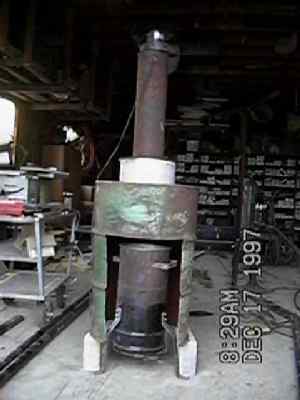Testing Stoves With a Vent Hood
Check out a Thesis by Grant Ballard-Tremeer which promotes the use of
vent hoods for the testing and evaluation of rural cooking stoves.
http://www.ilink.co.za/~grantt/
After reading his thesis I was motivated to try and apply it to the
testing of the One-Can Charcoal Making stove.
 The stove fits
inside the cut out oil drum. A short length of pipe on top leads to a small,
high temperature, fan which provides just enough draft to capture all the
combustion gasses. This was only clear to me when the stove lost flame
and billowed smoke which did not come out the side opening. The draft showed
very little effect on a flame held at the top of the side opening.
The stove fits
inside the cut out oil drum. A short length of pipe on top leads to a small,
high temperature, fan which provides just enough draft to capture all the
combustion gasses. This was only clear to me when the stove lost flame
and billowed smoke which did not come out the side opening. The draft showed
very little effect on a flame held at the top of the side opening.
To
determine the flow rate I measured the time it took to fill about 8 meters
of a 15cm diameter tube. The fan with this set up could move about .57
m3/sec. This is about 5 or 6 time the volume of air used by the stove.
This facilitates continuous sampling with my CO meter due to the lower
temperatures of the gasses. It also means that during periods when CO concentrations
rose they were still below the tools limit of 2000ppm.
Previously I had been taking samples from inside the stove at pot level
with no assurance that the emissions were consistent on all sides of the
shielded pot.
Most important for me is that I can now, by hooking up this fan to a
chimney, isolate the emissions from my own lungs. This device will now
ocupy a tiny corner of a heated room where tests can be made during the
winter sheltered from finger freezing ambiant temperatures.
back to the home page
 The stove fits
inside the cut out oil drum. A short length of pipe on top leads to a small,
high temperature, fan which provides just enough draft to capture all the
combustion gasses. This was only clear to me when the stove lost flame
and billowed smoke which did not come out the side opening. The draft showed
very little effect on a flame held at the top of the side opening.
The stove fits
inside the cut out oil drum. A short length of pipe on top leads to a small,
high temperature, fan which provides just enough draft to capture all the
combustion gasses. This was only clear to me when the stove lost flame
and billowed smoke which did not come out the side opening. The draft showed
very little effect on a flame held at the top of the side opening.